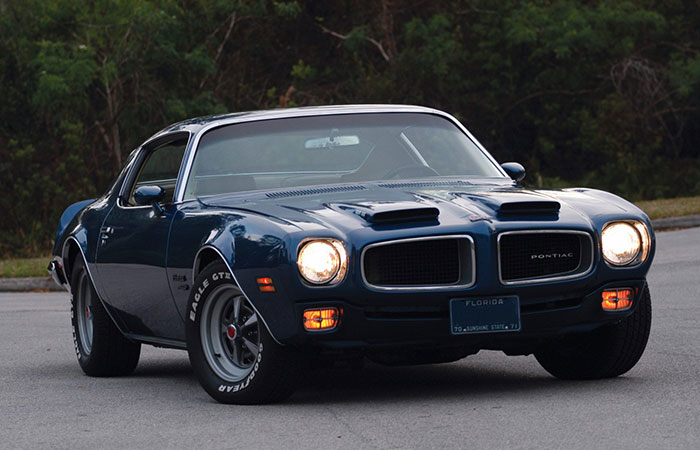The 1970 Pontiac Firebird: Why You Should Own This American Icon
When it comes to classic American muscle, few cars command attention like the 1970 Pontiac Firebird. This second-generation Firebird marked a radical departure from the first-gen models, introducing a sleeker, more aerodynamic design and an array of high-performance V8s that could go toe-to-toe with the best muscle cars of the era.
If you’re a collector or an enthusiast looking to add a truly special piece of American automotive history to your garage, here’s why the 1970 Firebird—particularly in Formula 400 or Trans Am trim—deserves a prime spot in your collection.
A Revolutionary Redesign That Stood the Test of Time
Pontiac didn’t just refresh the Firebird in 1970—it completely reinvented it. The second-generation Firebird boasted a longer, lower, and wider body, with dramatic sculpted lines that made it look more aggressive than ever before.
Gone were the first-gen’s squared-off edges and upright stance; in their place was a European-inspired design, featuring a long hood, sloped rear deck, and flared fenders that made the Firebird look fast even when standing still.
Aero-Inspired Design That Was Ahead of Its Time
Unlike its Chevrolet Camaro sibling, the 1970 Firebird was designed with aerodynamics in mind. Engineers took cues from European sports cars, focusing on wind tunnel testing to improve high-speed stability and performance. The result? A car that sliced through the air more efficiently than most of its muscle car rivals.
The standout feature of the new design was its iconic split front grille—a styling cue that would become synonymous with the Firebird for years to come. And for those who opted for the Trans Am package, Pontiac went all out, adding a massive shaker hood scoop, bold racing stripes, and an aggressive rear spoiler that screamed performance.
Simply put, the 1970 Firebird looked like nothing else on the road, and that uniqueness alone makes it a must-have in any collection.
Muscle Car Performance at Its Finest
A great muscle car isn’t just about looks—it’s about what’s under the hood. And the 1970 Pontiac Firebird delivered serious power.
While the base models came with inline-six and small-block V8 options, true enthusiasts opted for the Formula 400 or Trans Am models, which packed monstrous V8s capable of embarrassing just about anything else on the road.
Top Performance Engines:
Firebird Formula 400 – Powered by a 400 cubic-inch (6.6L) V8, this beast churned out 345 horsepower and 430 lb-ft of torque—serious numbers for its time.
Trans Am Ram Air III – Upgraded with improved breathing and a more aggressive camshaft, this 400 cubic-inch V8 produced 366 horsepower.
Trans Am Ram Air IV – The ultimate factory engine for 1970, the Ram Air IV 400 V8 was rated at 370 horsepower, but many believe it actually made well over 400 hp.
These engines weren’t just about raw power—they were tuned for performance. With quadrajet carburetors, high-lift cams, and free-flowing exhaust systems, the 1970 Firebird was built to dominate the quarter-mile and the open road.
Handling That Set It Apart
One of the biggest advantages of the second-gen Firebird over its competitors was its handling. While most muscle cars of the era focused on straight-line speed, Pontiac engineers worked on refining the chassis and suspension.
The Trans Am models, in particular, received:
Upgraded suspension components
Front and rear sway bars
High-performance shocks
Wider track for improved stability
This meant that the Firebird could carve corners in a way that Mustangs and Challengers simply couldn’t. It was a muscle car that felt refined and balanced, making it one of the best-handling American cars of its time.
Trans Am Racing Pedigree
Pontiac wasn’t just building muscle cars for the street—it was building cars to win on the track.
The 1970 Trans Am Firebird was born from SCCA Trans-Am racing, where Pontiac competed against heavyweights like the Boss 302 Mustang and Camaro Z/28.
While the street versions were slightly detuned from their race-ready counterparts, they retained the aggressive suspension tuning, race-inspired aerodynamics, and big-power engines that made them serious contenders on both the street and the track.
For collectors who appreciate a car with real motorsports history, the 1970 Firebird Trans Am isn’t just a muscle car—it’s a race-bred machine.
A Rarity That’s Gaining Value
If you’re a collector, you know that rarity drives value—and the 1970 Firebird is one of the rarest muscle cars of its era.
Production Numbers:
Total 1970 Firebird Production: 48,739
Formula 400 Production: 7,708
Trans Am Production: 3,196
Ram Air III Trans Am: ~2,200
Ram Air IV Trans Am: ~88 (one of the rarest Firebirds ever)
With less than 3,200 Trans Ams built in 1970, finding a numbers-matching example today is a serious challenge. Well-preserved and original Firebirds are appreciating rapidly, with Trans Am models commanding six-figure price tags at auction.
If you’re looking for a blue-chip investment in the muscle car market, a 1970 Firebird—especially a Trans Am Ram Air IV—is a sure bet.
A Driving Experience Unlike Anything Else
Owning a classic car isn’t just about looking at it in your garage—it’s about driving it.
Behind the Wheel of a 1970 Firebird:
Turn the key, and you’re greeted with the unmistakable rumble of a high-compression V8.
The shaker hood scoop moves with the throttle, giving you a direct connection to the engine.
The 4-speed manual transmission puts you in complete control, making every gear shift an event.
The car feels planted yet raw, thanks to its balanced suspension and wide track.
Whether you’re cruising down the highway or blasting through backroads, the 1970 Firebird delivers an experience that modern muscle cars simply can’t replicate.
Why You Should Add One to Your Collection
The 1970 Pontiac Firebird isn’t just another classic muscle car—it’s a turning point in American performance history. It represents a perfect blend of aggressive styling, high-performance V8 power, and track-inspired handling, making it one of the most well-rounded muscle cars ever built.
Reasons to Own One:
✅ Stunning, timeless design
✅ Powerful and high-revving V8 options
✅ One of the best-handling muscle cars of its era
✅ Racing pedigree from the Trans Am series
✅ Extremely rare and appreciating in value
✅ A visceral driving experience that’s pure and unfiltered
If you want a classic muscle car that stands out from the crowd, the 1970 Pontiac Firebird is the perfect choice. Whether you’re looking for a Formula 400 for street thrills or a Trans Am Ram Air IV for investment potential, this is one car that belongs in your garage—and on the road.

